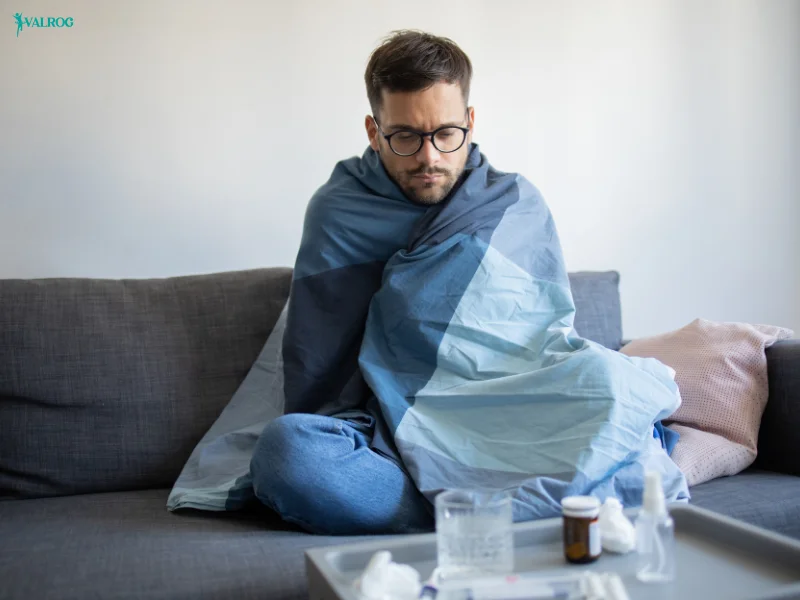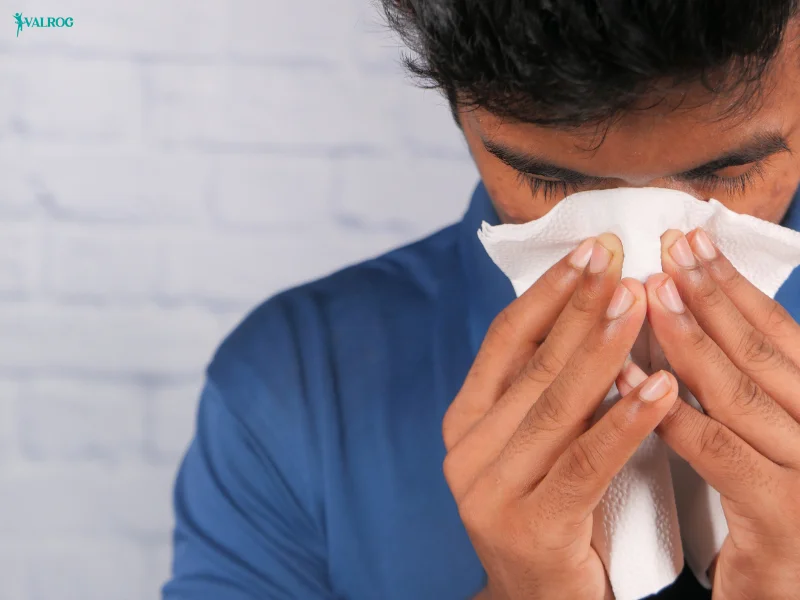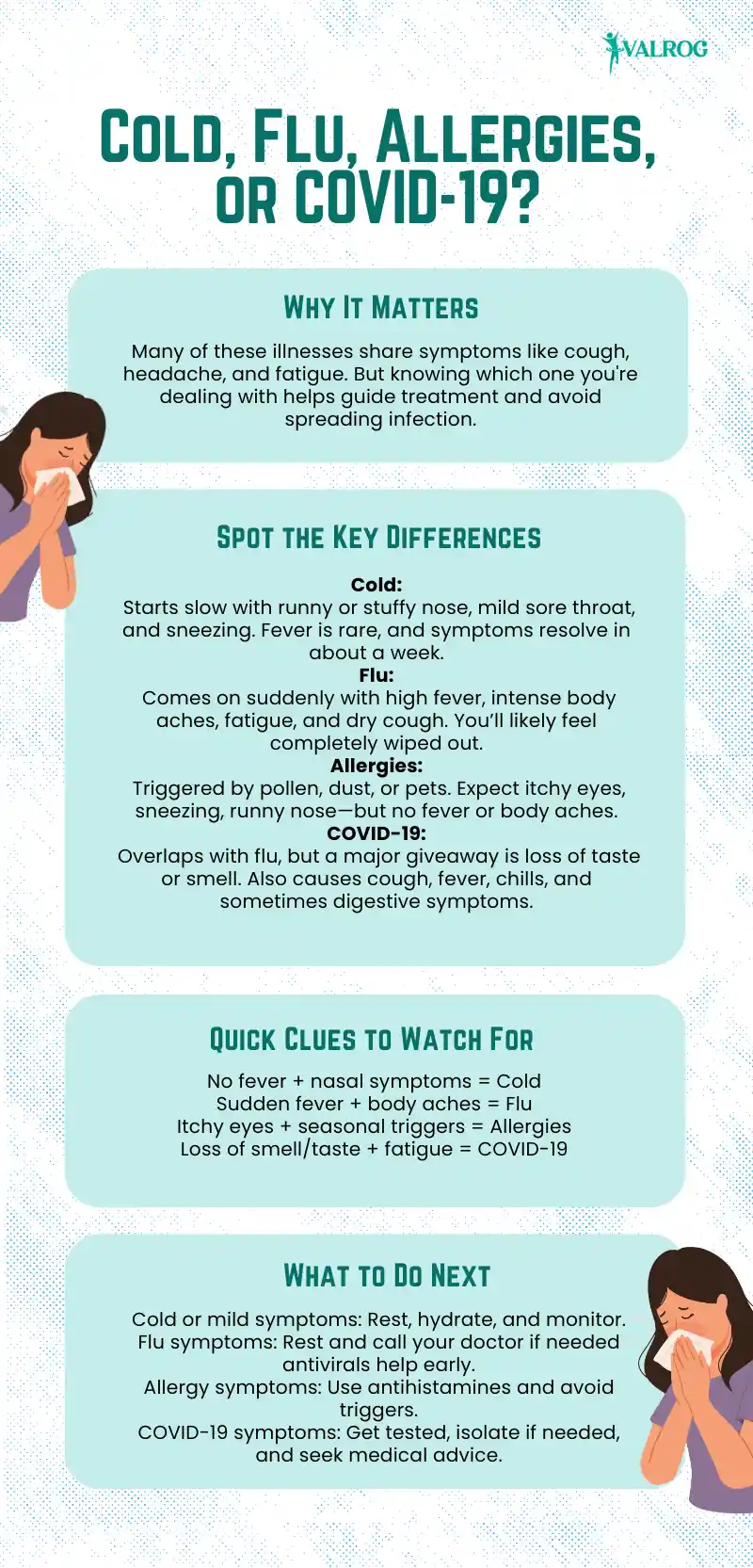“Knowing what you have isn’t just about comfort. It’s about action.”
Imagine waking up with a dry cough and headache and fever. Do you have the flu? COVID-19? or just allergies? In a world that is just starting to adjust to a post-pandemic lifestyle, it can be advantageous to understand the difference between these similar conditions so that you can not only receive the proper medication but also avoid spreading the condition to others.
Cold, flu, allergy, and COVID-19 can be divided regarding their symptoms, severity, and key differences with the assistance of easy-to-understand comparisons and real-life illustrations.
Why It Matters to Differentiate
Cough and headache and fever could be a sign of many diseases. Nevertheless, they are all characterized by various peculiarities which affect the degree of their spreading, treatment, and duration. There are so many similar symptoms; it pays to know, in order to help yourself and others, as well.

Explore: Emotional and Behavioral Disorders (EBD): Symptoms, Causes and What to Know
Cold Symptoms and What They Mean
Colds are mild viral diseases. They normally commence with a runny nose or sore throat and seldom entail high fever as well as body aches.
Key symptoms:
- Runny/stuffy nose
- Mild sore throat
- Sneezing
- Mild dry cough and headache
- Rare or low-grade fever
Duration: 7–10 days
Treatment: Rest, fluids, and over-the-counter relief like acetaminophen. No antivirals are needed.
Tip: If you feel a little tired with nasal symptoms but no serious aches, it’s likely a cold.
Flu: Quick Onset and Intense Symptoms
Influenza is more aggressive than the cold. Symptoms come on fast, often in hours.
Typical signs:
- Sudden high fever chills body aches
- Intense headache chills body aches
- Dry cough and headache
- Fatigue and weakness
Duration: Usually 3–7 days, but fatigue can last longer.
Treatment: Antiviral meds like oseltamivir (Tamiflu) are effective if started early. Rest and hydration are crucial.
Tip: Sudden fatigue paired with fever, body chills, and dry cough is a strong sign it’s the flu.

Allergies: No Fever, Just Misery
Unlike viral infections, allergies are caused by your immune system overreacting to allergens.
Common symptoms:
- Runny or stuffy nose
- Sneezing
- Itchy eyes, throat, or nose
- Mild headache, tiredness
- Dry cough, especially from post-nasal drip
What’s missing? No fever body aches headache combination. No chills.
Duration: Weeks or months, depending on exposure.
Treatment: Antihistamines, nasal corticosteroids, and trigger avoidance.
Clue: When the symptoms persist for weeks and are more severe in the outdoors or when pollen is in season, it is probably allergies.
Learn More: Acetaminophen vs Ibuprofen: Which One Should You Choose?
COVID-19: The Game Changer
COVID-19 varies between common cold-like conditions and serious respiratory problems. Numerous symptoms are the same as those of the flu, whilst others are distinctive
Common symptoms:
- Cough and headache and fever
- Body chills fever body aches
- Loss of taste or smell
- Shortness of breath
- GI symptoms in some cases
Duration: Mild cases take approximately 10 days to resolve. Long COVID may occur.
Treatment: In high-risk groups, rest, hydration, and antiviral medications. It is vital to test.
Tip: Loss of taste or smell, the sudden appearance of fever, fatigue, and dry cough is indicative of COVID-19
Key Symptom Comparison Table
| Symptom | Cold | Flu | Allergies | COVID-19 |
| Fever | Rare | Common | Never | Common |
| Body aches | Mild | Severe | None | Common |
| Dry cough and headache | Mild | Common | Possible | Common |
| Runny nose | Common | Common | Common | Sometimes |
| Fatigue | Mild | Strong | Sometimes | Often |
| Chills | Rare | Common | No | Common |
| Loss of taste/smell | No | Rare | No | Often |
| Itchy eyes/nose | No | No | Common | No |
What Makes Each Illness Unique
- Cold: Slow to develop, primarily nasal congestion and symptoms, occasional chills, and myalgia.
- Flu: Sharp and severe fever chills body aches headache fatigue cough.
- Allergies: The environment causes them, no fever, symptoms connected to exposure.
- COVID-19: Dry cough and headache and fever, peculiar loss of smell or taste.

Check this out: Is Stainless Steel Non Toxic? Full Comparison with Cast Iron
What Should You Do?
When You Have:
- Mild illness (runny nose, mild cough, lack of fever): Rest and drink fluids. Probably a cold.
- High fever, chills and aches all over: Think flu. Reach your physician.
- Itchy eyes, sneezing, runny nose: Allergy medications could be used.
- Fever body aches headache and loss of smell or taste: Get tested for COVID-19 instantly.
Testing and Isolation
- COVID-19: Do a PCR or rapid test. Isolate for 24 hours without fever.
- Flu: Testing may be an option when you are at high risk or have severe symptoms.
Real-World Examples
- Example 1: You are tired, your throat is sore, and you have a dry cough and headache, yet no fever, maybe a cold.
- Example 2: You wake with a high fever, body aches, headache, and fatigue that came upon you overnight- flu is likely.
- Example 3: You have a runny nose, itchy eyes, and it occurs every spring. That’s allergies.
- Example 4: You feel so tired, your cough is dry, and you cannot taste your breakfast-take a COVID-19 test.
Home Remedies & Medical Treatment
- Hydration and rest help with all viral illnesses.
- Fever body aches headache can be managed with OTC medications.
- Antivirals are effective for flu and COVID-19 if given early.
- Allergy treatment includes antihistamines and nasal sprays.
Preventive Tip: Keep your immune system strong with sleep, exercise, and a balanced diet.
Final Thoughts
Knowing what is happening to your body, whether you have a cold or COVID-19, will help you make the best decisions. A cough and headache and fever may be a variety of things, but now, you are prepared to interpret the symptoms.
In our modern realities, it has become more critical to understand the distinction between a cold, the flu, allergies, and COVID-19. Cough and headache and fever may not be such a big deal, but knowing the reason will make you behave in a specific way: to stay at home and rest, to start the antiviral medication, or to get tested. Despite the fact that the symptoms could be alike, the key symptoms, including pains throughout the body, fatigue, or loss of smell, could direct your next step.
Be mindful of your body and when a test is needed, seek one of high quality, and never ignore symptoms that never fade or become more severe. When you are not sure about this, just to be on the safer side, consult a doctor so that you are sure and the people that are around you are also safe.
And the Knowledge is Power.
